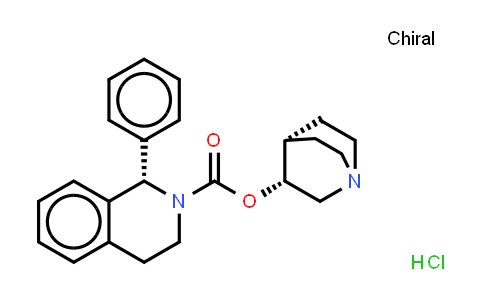| Chemical Name |
Solifenacin (hydrochloride) |
| CAS Number |
180468-39-7 |
| MDL Number |
MFCD09953430 |
| Molecular Formula |
C23H27ClN2O2 |
| Molecular Weight |
398.93 |
| Synonyms |
YM905 hydrochloride |
Introduction of 180468-39-7 :
Solifenacin hydrochloride (YM905 hydrochloride) is a muscarinic receptor antagonist, with pKis of 7.6, 6.9 and 8.0 for M1, M2 and M3 receptors, respectively. IC50 & Target: Muscarinic receptor In Vitro: Solifenacin hydrochloride (YM905 hydrochloride) is a novel muscarinic receptor antagonist with pKis of 7.6±0.056, 6.9±0.034 and 8.0±0.021 for M1, M2 and M3 receptors, respectively. In murine submandibular gland cells, the antagonistic effects of 100 nM Solifenacin hydrochloride and oxybutynin on Ca2+ mobilization evoked by varying doses of carbachol (CCh) are examined. Solifenacin hydrochloride does not shift the CCh dose-activation curve in a parallel manner whereas oxybutynin shows insurmountable antagonism. The pKb values are obtained as 7.4±0.17 for Solifenacin hydrochloride and 8.8±0.21 for oxybutynin[1]. In Vivo: Solifenacin hydrochloride (YM905 hydrochloride) reduces bladder responses by 40% at a dose of 210 nmol/kg (0.1 mg/kg) and abolishes them at 2100 nmol/kg (1 mg/kg). In contrast, its inhibitory effects on salivary and cardiac responses are only slight at 630 nmol/kg (0.3 mg/kg), and reach 66% and 49%, respectively, at 2100 nmol/kg (1 mg/kg). At doses of 63 and 210 nmol/kg (0.03 and 0.1 mg/kg), Solifenacin hydrochloride slightly increases saliva secretion[1]. Solifenacin hydrochloride (0.01 to 0.3 mg/kg i.v.) dose-dependently increases bladder capacity and voided volume at doses of 0.03 mg/kg i.v. or more, but does not affect residual volume or micturition pressure at any dose tested[2].
| Purity |
NLT 98% |
| Storage |
at 20ºC 2 years |
*The above information is for reference only.
